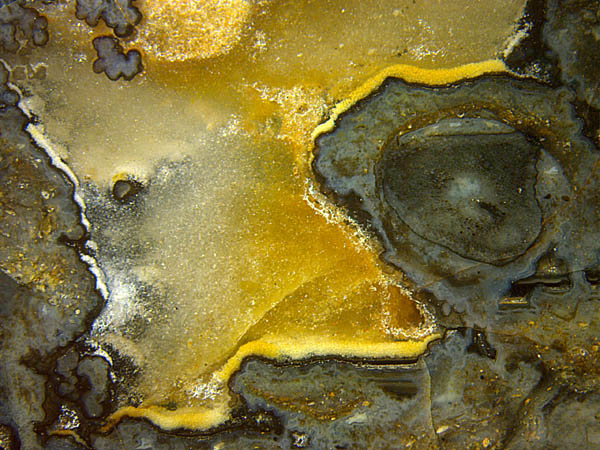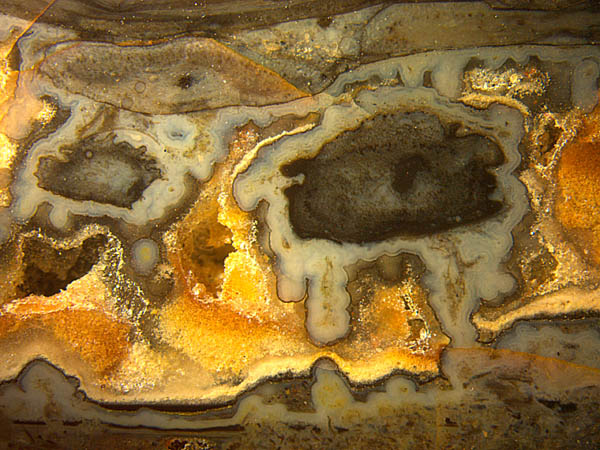"Snowing" siliceous flakes preserved
in Rhynie chert
 This
image provides the illusion of an intermediate stage of chert
formation, with silica flakes seen as tiny white
dots "snowing" down and accumulating at the bottom and on ledges of
sloping walls
of a cavity in silica gel, filled
with water then but now with solid fill except for small remaining
quartz-lined holes on the right.
This
image provides the illusion of an intermediate stage of chert
formation, with silica flakes seen as tiny white
dots "snowing" down and accumulating at the bottom and on ledges of
sloping walls
of a cavity in silica gel, filled
with water then but now with solid fill except for small remaining
quartz-lined holes on the right.
Fig.1: Former water-filled cavity between silica gel, visualizing the
precipitation of siliceous flakes.
Width of Figs.1-3: 11mm.
The sequence of events leading to the aspect in Figs.1,3
can be reconstructed: It started with plants upset, submerged,
and decaying. Apparently the decay products had caused the silica-rich
water to form silica gel
around the decaying
plants, with water-filled pockets left in between. Apparently
the growth of gel ended suddenly when the dissolved silica had been
used up.
The gel surface stayed put, which enabled microbes to settle there,
leaving black coatings. (See also Rhynie
Chert News 83, )
Remarkably, additional silica entering into the
water-filled
cavity did not get stuck to the silica gel walls but
formed white
flakes or grains which
sank to the bottom or settled
on the ledges of the cavity walls, seen as white deposits on the
left. Apparently the yellow stain is a later addition
independent of the precipitation.
Eventually the water in the cavity became more
viscous so that the
grains did not sink any more but are seen now as tiny white dots
seemingly suspended in space.
Fig.2: Former
water-filled crack in silica gel with siliceous
precipitate settled mainly on the lower crack face; deformed Aglaophyton
section above left.

The precipitation of siliceous
flakes or grains was not restricted to the
water-filled cavities left during early gel formation but also was
going on inside wide cracks.
The variable crack opening in Fig.2 indicates that the
whole was still soft. Part of the crack
faces had got a thin black microbial coating, less conspicuous than in
Fig.1.
As a peculiarity in Fig.2, there are two small parallel black stripes
without
yellow "snow". They must have formed earlier,
similar as described in Rhynie
Chert News 75.
They indicate
the horizontal direction during silicification,
thus being compatible with the perpendicular
direction of "snowfall" in Figs.1-3.

Fig.3 (right): Poorly
preserved Aglaophyton
covered with pale silica gel; former
water-filled cavities with quartz grains
or empty now.
It is readily concluded from Fig.3 that the sequence of events started
with plants upset, submerged, and decaying,
causing the siliceous water to make pale silica gel around them. The
well-defined gel surface got a thin coating of microbes, now seen
as a thin black line on top of the
gel. Apparently the concentration of dissolved silica had become so low
then that no additional gel was formed but very
slowly growing crystalline quartz instead, also in closed cavities,
where SiO2 came in via
diffusion. Likewise
the water disappeared.
Sample: Rh2/10 (5.48kg)
obtained from M. Shanks in 2000, here Part3 (3.31kg).
H.-J.
Weiss 2022
 |
 |
189 |


 This
image provides the illusion of an intermediate stage of chert
formation, with silica flakes seen as tiny white
dots "snowing" down and accumulating at the bottom and on ledges of
sloping walls
of a cavity in silica gel, filled
with water then but now with solid fill except for small remaining
quartz-lined holes on the right.
This
image provides the illusion of an intermediate stage of chert
formation, with silica flakes seen as tiny white
dots "snowing" down and accumulating at the bottom and on ledges of
sloping walls
of a cavity in silica gel, filled
with water then but now with solid fill except for small remaining
quartz-lined holes on the right. 


